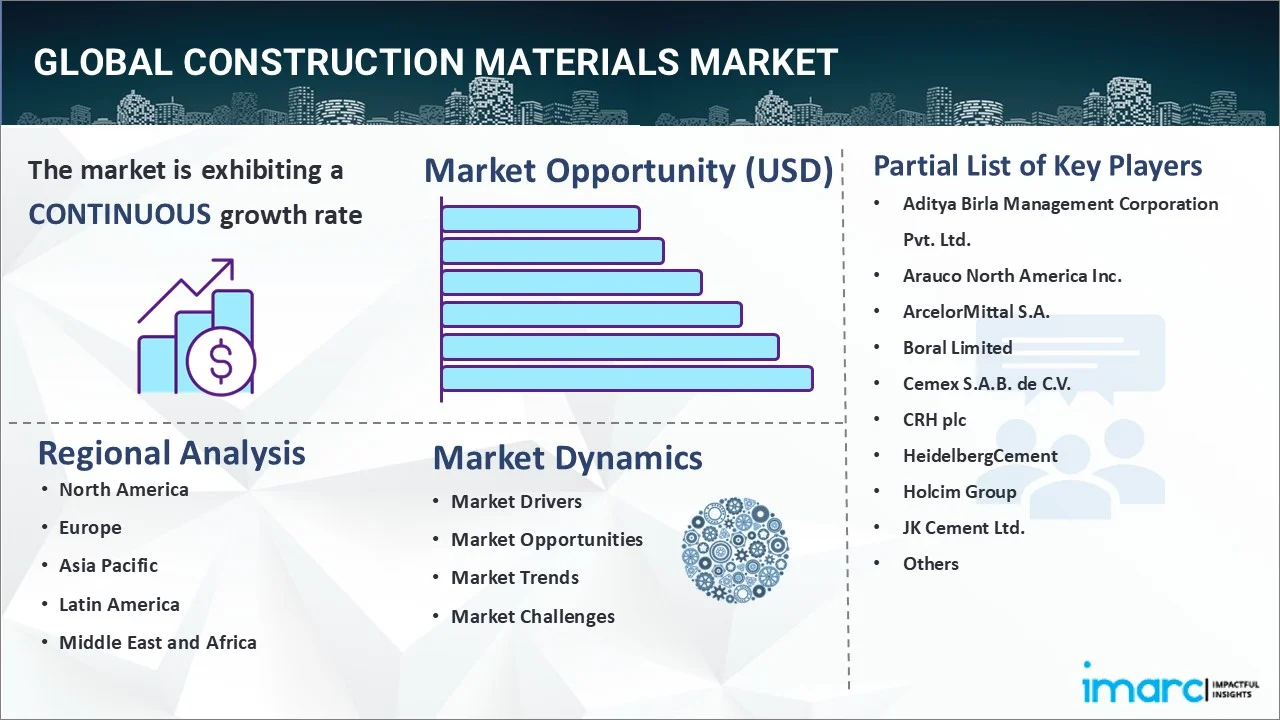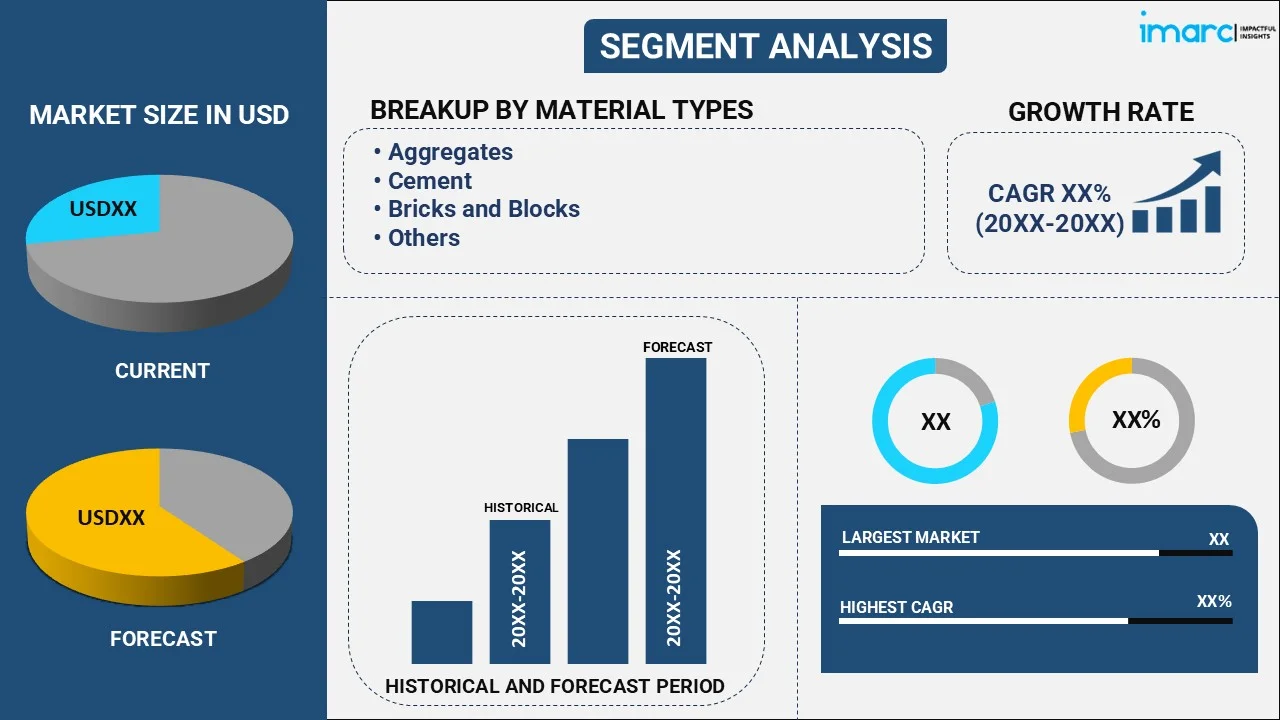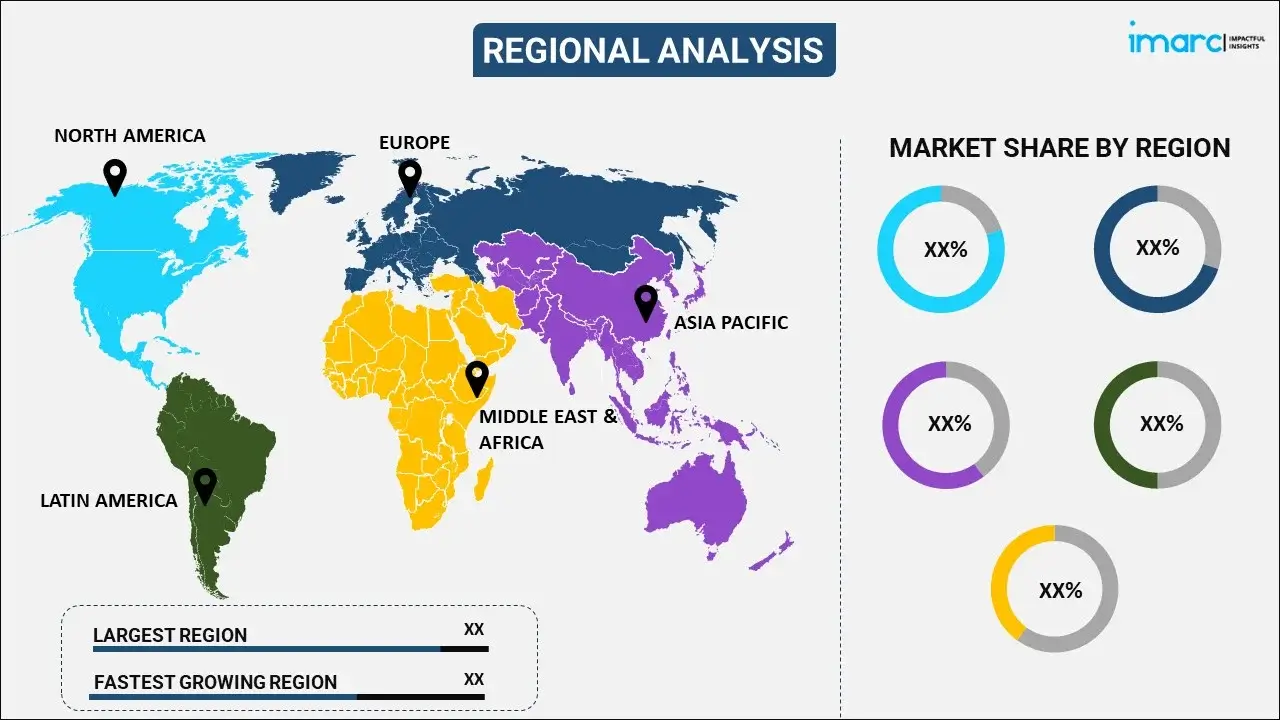
Construction Materials Market by Material Type (Aggregates, Cement, Bricks and Blocks, Metals, and Others), End User (Residential, Infrastructure, Commercial, Industrial), and Region 2025-2033
Market Overview:
The global construction materials market size reached USD 1,271.7 Million in 2024. Looking forward, IMARC Group expects the market to reach USD 1,746.9 Million by 2033, exhibiting a growth rate (CAGR) of 3.59% during 2025-2033. The growing construction of commercial and residential buildings, rising adoption of new manufacturing processes, and increasing investments by governing agencies of various countries on improving public infrastructure are some of the major factors propelling the market.
|
Report Attribute
|
Key Statistics |
|---|---|
|
Base Year
|
2024 |
|
Forecast Years
|
2025-2033
|
|
Historical Years
|
2019-2024
|
| Market Size in 2024 | USD 1,271.7 Million |
| Market Forecast in 2033 | USD 1,746.9 Million |
| Market Growth Rate (2025-2033) |
3.59%
|
Construction materials comprise stone aggregates, cement, concrete, bricks, sand, gravel, and asphalt, which are employed in the construction of buildings, pavements, and various other infrastructure. These materials offer durability and resistance against fire, chemicals, and other external stimuli, such as sunlight, air, and rain. They can withstand harsh weather conditions and provide heat conductivity to keep the interior temperatures lower than the exterior. Furthermore, they are used for constructing decorative sculptures, statues, bookshelves, patios, and concrete tables in outdoor spaces.

At present, the increasing demand for construction materials, as they possess enhanced tensile strength, density, and thermal capacity and offer weathering resistance, is impelling the growth of the market. Besides this, rising construction of commercial infrastructure and residential apartments around the world is contributing to the growth of the market. In addition, the growing adoption of enhanced manufacturing processes and technological advancements in installation processes are positively influencing the market. Apart from this, increasing investments by governing agencies of various countries in improving the conditions of public infrastructures, along with rising renovation and reconstruction activities of various heritage sites and monuments, are supporting the growth of the market. Additionally, the growing utilization of various recycled construction materials, including crushed concrete and gypsum, bricks, and numerous metals, to prevent pollution is positively influencing the market.
Construction Materials Market Trends/Drivers:
Rising demand for innovative construction materials stimulating market growth
At present, there is an increase in the utilization of innovative construction materials as they enhance the overall condition of the infrastructure. These materials include reinforced concrete, self-healing concrete, and pollution absorbing bricks. They also consist of pigmented concrete manufactured by adding appropriate pigment admixtures to cement, gravel, sand, and water to form colored concrete mixtures. Pigmented concrete also enhances the aesthetics of buildings and eliminates the requirement for paints and sealants. Besides this, there is a rise in the demand for light-generating cement, as it can absorb sun rays during the daytime and emit it in the nighttime due to its crystallization properties.
Increasing construction of smart cities catalyzing demand for construction materials
Smart cities rely on information and communication technology (ICT) to increase operational efficiency, share data with the public, and offer a better quality of life to the citizens. Their main function is to optimize city functions and promote economic growth while utilizing smart technology and data analysis. As a result, governing agencies of various countries are undertaking initiatives to build smart cities, which is catalyzing the demand for various eco-friendly and sustainable construction materials. Besides this, the employment of environment-friendly construction materials in smart cities plays the quintessential role, as they do not increase the impact of air pollution and climate change and can be reused or recycled to prevent their accumulation in landfills and water bodies. Smart cities are constructed with smart concrete, which contains a small number of short carbon fibers to modify its electrical resistance in response to strain or stress.
Rising construction of roads and highways augmenting market growth
At present, the increasing construction of roads and highways around the world represents one of the crucial factors catalyzing the demand for construction materials. Governing agencies of various countries are focusing on increasing the number of roads and highways in remote localities to facilitate social and economic development. They are also planning to enhance the overall transportation system of regions so that citizens can easily travel to other locations by roads and highways, which is further increasing the utilization of construction materials. Construction materials with high durability and smooth finish, such as concrete, cement, or Portland cement, is utilized for the construction of bridges, roads, and highways as they are durable and capable of withstanding harsh climate conditions.
Construction Materials Industry Segmentation:
IMARC Group provides an analysis of the key trends in each segment of the global construction materials market report, along with forecasts at the global, regional, and country levels from 2025-2033. Our report has categorized the market based on material type and end user.
Breakup by Material Type:

- Aggregates
- Cement
- Bricks and Blocks
- Metals
- Others
Aggregates represents the most popular construction materials
The report has provided a detailed breakup and analysis of the construction materials market based on the material type. This includes aggregates, cement, bricks and blocks, metals, and others. According to the report, aggregates represented the largest segment. Aggregates comprise a broad range of coarse to medium-grained particulate materials, including gravel, crushed stone, and sand, which are extracted from pits and quarries. They are often combined with other binding elements, including water, cement, and asphalt, to form compound substances like asphalt concrete and Portland cement concrete. They help enhance the mechanical strength of concrete. They are used for construction purposes to fill voids, protect pipes, and provide a hard surface.
Cement is a powdered substance manufactured by calcining lime and clay and mixed with water to form mortar or combined with sand, gravel, and water and make concrete. It is primarily employed as a binder in concrete, which is utilized for the construction of houses, roads, schools, hospitals, dams, and ports. Cement is also used for creating decorative items, including sculptures and statues.
Bricks and blocks are rectangular-shaped construction materials made from clay or various other durable materials and hardened by drying in the sun or dehydrating in a kiln. They are kept on top of one another and joined with cement or mortar.
Metals like aluminum, titanium, iron, copper, and steel are widely utilized for construction purposes. They are often employed to form pipes and tubing and for cladding exterior walls.
Breakup by End User:
- Residential
- Infrastructure (It Includes Roads, Bridges, Waste Management are Considered)
- Commercial
- Industrial
Residential holds the largest share of the market
A detailed breakup and analysis of the construction materials market based on the end user has also been provided in the report. This includes residential, infrastructure (it includes roads, bridges, waste management are considered), commercial and industrial. According to the report, residential accounted for the largest market share. At present, rising construction of residential complexes around the world that are equipped with numerous amenities, including swimming pools, gymnasiums, meeting halls, and parks, is catalyzing the demand for construction materials in the residential sector. Besides this, the rising global population is encouraging realtors and constructors to produce a greater number of residential complexes and apartments.
Infrastructure development, comprising the construction of roads, bridges, dams, ports, as well as highways, requires a wide variety of durable and sustainable materials. Governing agencies of various countries are financing construction of roads and highways for better transportation and connecting various remote locations. They are also investing in building proper waste management systems to prevent waste materials from ending up in landfills or water bodies.
Commercial buildings, including schools, colleges, hospitals, nursing homes, clinics, and shopping malls are rising in number around the world, which is enhancing the quality of living of individuals and catalyzing the demand for construction materials.
The rising industrial development with the emergence of various profitable and productive sectors is contributing to the growth of the construction materials market. A large number of industrial setups, warehouses, and manufacturing plants are built by various companies, which is further impelling the demand for construction materials.
Breakup by Region:

- North America
- United States
- Canada
- Europe
- Germany
- France
- United Kingdom
- Italy
- Spain
- Others
- Asia Pacific
- China
- Japan
- India
- South Korea
- Australia
- Indonesia
- Others
- Latin America
- Brazil
- Mexico
- Others
- Middle East and Africa
North America exhibits a clear dominance, accounting for the largest construction materials market share
The report has also provided a comprehensive analysis of all the major regional markets, which include North America (the United States and Canada); Europe (Germany, France, the United Kingdom, Italy, Spain, and others); Asia Pacific (China, Japan, India, South Korea, Australia, Indonesia, and others); Latin America (Brazil, Mexico, and others); and the Middle East and Africa.
North America held the biggest market share since the region has a developed industrial infrastructure. Besides this, the growing real estate investments, along with the rising popularity of decorative concrete, are further catalyzing the demand for construction materials. Another contributing factor is increasing construction of residential and commercial buildings along with the rising demand for sustainable construction materials. Besides this, rising initiatives to provide affordable housing to poor citizens is propelling the growth of the market.
Asia Pacific is estimated to expand further in this domain on account of the rising construction of healthcare facilities to provide quality healthcare services and the increasing availability of prefabricated modular building blocks.
Competitive Landscape:
Key players are experiencing a rise in the demand for construction materials due to the increasing construction of residential, commercial, and industrial infrastructures around the world. They are focusing on manufacturing various innovative products, including ready-mix concrete and cement, to simplify the entire construction procedure for builders. They are also collaborating with realtors and constructors to expand their business operations by providing raw materials in bulk. Apart from this, they are engaging in mergers and acquisitions (M&As) with other small-scale enterprises to increase their production facilities and connect with a greater number of customers. Top companies are investing in the production of a wide variety of innovative, including self-healing construction materials, which are capable of restoring their mechanical strength and physical properties after getting exposed to or affected by any kind of external stimuli, such as light, air, and chemicals.
The report has provided a comprehensive analysis of the competitive landscape in the global construction materials market. Detailed profiles of all major companies have also been provided. Some of the key players in the global construction materials market include:
- Aditya Birla Management Corporation Pvt. Ltd.
- Arauco North America Inc.
- ArcelorMittal S.A.
- Boral Limited
- Cemex S.A.B. de C.V.
- CRH plc
- HeidelbergCement
- Holcim Group
- JK Cement Ltd.
- Kronoplus Limited
- Nippon Steel Corporation
- Sika AG
Recent Developments:
- In May 2022, Arauco North America Inc. announced that it would invest $20 million to increase its thermally fused lamination (TFL) operations at its state-of-the-art particleboard mill in Grayling, Michigan.
- In October 2021, Boral Limited completed the sale of its Australian Timber business for A$64.5 million to Pentarch Group.
- In October 2022, Nippon Steel Corporation announced the initiation of the studies to shift from the blast furnace steelmaking process to an electric arc furnace steelmaking process at Setouchi Works Hirohata Area, as the managing temperature in an electric arc system is easier than in a blast furnace.
Construction Materials Market Report Scope:
| Report Features | Details |
|---|---|
| Base Year of the Analysis | 2024 |
| Historical Period | 2019-2024 |
| Forecast Period | 2025-2033 |
| Units | Million USD |
| Scope of the Report | Exploration of Historical and Forecast Trends, Industry Catalysts and Challenges, Segment-Wise Historical and Predictive Market Assessment:
|
| Material Types Covered | Aggregates, Cement, Bricks and Blocks, Metals, Others |
| End Users Covered | Residential, Infrastructure, Commercial, Industrial |
| Regions Covered | Asia Pacific, Europe, North America, Latin America, Middle East and Africa |
| Countries Covered | United States, Canada, Germany, France, United Kingdom, Italy, Spain, China, Japan, India, South Korea, Australia, Indonesia, Brazil, Mexico |
| Companies Covered | Aditya Birla Management Corporation Pvt. Ltd., Arauco North America Inc., ArcelorMittal S.A., Boral Limited, Cemex S.A.B. de C.V., CRH plc, HeidelbergCement, Holcim Group, JK Cement Ltd., Kronoplus Limited, Nippon Steel Corporation, Sika AG, etc. |
| Customization Scope | 10% Free Customization |
| Post-Sale Analyst Support | 10-12 Weeks |
| Delivery Format | PDF and Excel through Email (We can also provide the editable version of the report in PPT/Word format on special request) |
Key Questions Answered in This Report:
- How has the global construction materials market performed so far, and how will it perform in the coming years?
- What are the drivers, restraints, and opportunities in the global construction materials market?
- What is the impact of each driver, restraint, and opportunity on the global construction materials market?
- What are the key regional markets?
- Which countries represent the most attractive construction materials market?
- What is the breakup of the market based on the material type?
- Which is the most attractive material type in the construction materials market?
- What is the breakup of the market based on the end user?
- Which is the most attractive end user in the construction materials market?
- What is the competitive structure of the global construction materials market?
- Who are the key players/companies in the global construction materials market?
Key Benefits for Stakeholders
- IMARC’s report offers a comprehensive quantitative analysis of various market segments, historical and current market trends, market forecasts, and dynamics of the construction materials market from 2019-2033.
- The research study provides the latest information on the market drivers, challenges, and opportunities in the global construction materials market.
- The study maps the leading, as well as the fastest-growing, regional markets. It further enables stakeholders to identify the key country-level markets within each region.
- Porter's five forces analysis assists stakeholders in assessing the impact of new entrants, competitive rivalry, supplier power, buyer power, and the threat of substitution. It helps stakeholders to analyze the level of competition within the construction materials industry and its attractiveness.
- Competitive landscape allows stakeholders to understand their competitive environment and provides an insight into the current positions of key players in the market.
Need more help?
- Speak to our experienced analysts for insights on the current market scenarios.
- Include additional segments and countries to customize the report as per your requirement.
- Gain an unparalleled competitive advantage in your domain by understanding how to utilize the report and positively impacting your operations and revenue.
- For further assistance, please connect with our analysts.
 Inquire Before Buying
Inquire Before Buying
 Speak to an Analyst
Speak to an Analyst
 Request Brochure
Request Brochure
 Request Customization
Request Customization




.webp)




.webp)












